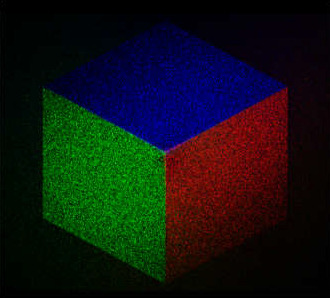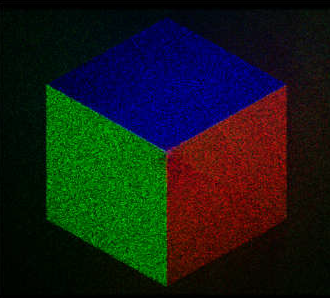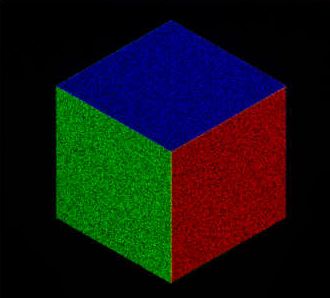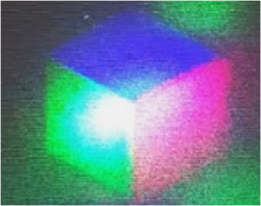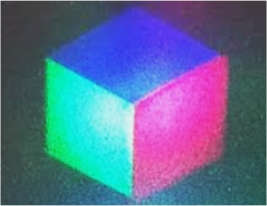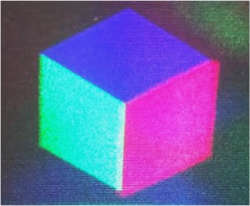Digital Holography and Computer Generated Holography
Everything you need to know about MD Optical Design's computer-generated holograms:
What is Digital Holography?
Digital holography involves the use of computational techniques to create holograms, which are three-dimensional images formed by the interference of light beams from a laser or another coherent light source. Unlike analog holography, which is limited to static displays, digital holography allows dynamic image generation, presenting possibilities for real-time changes to the holographic content.
What is a Computer Generated Hologram (CGH)?
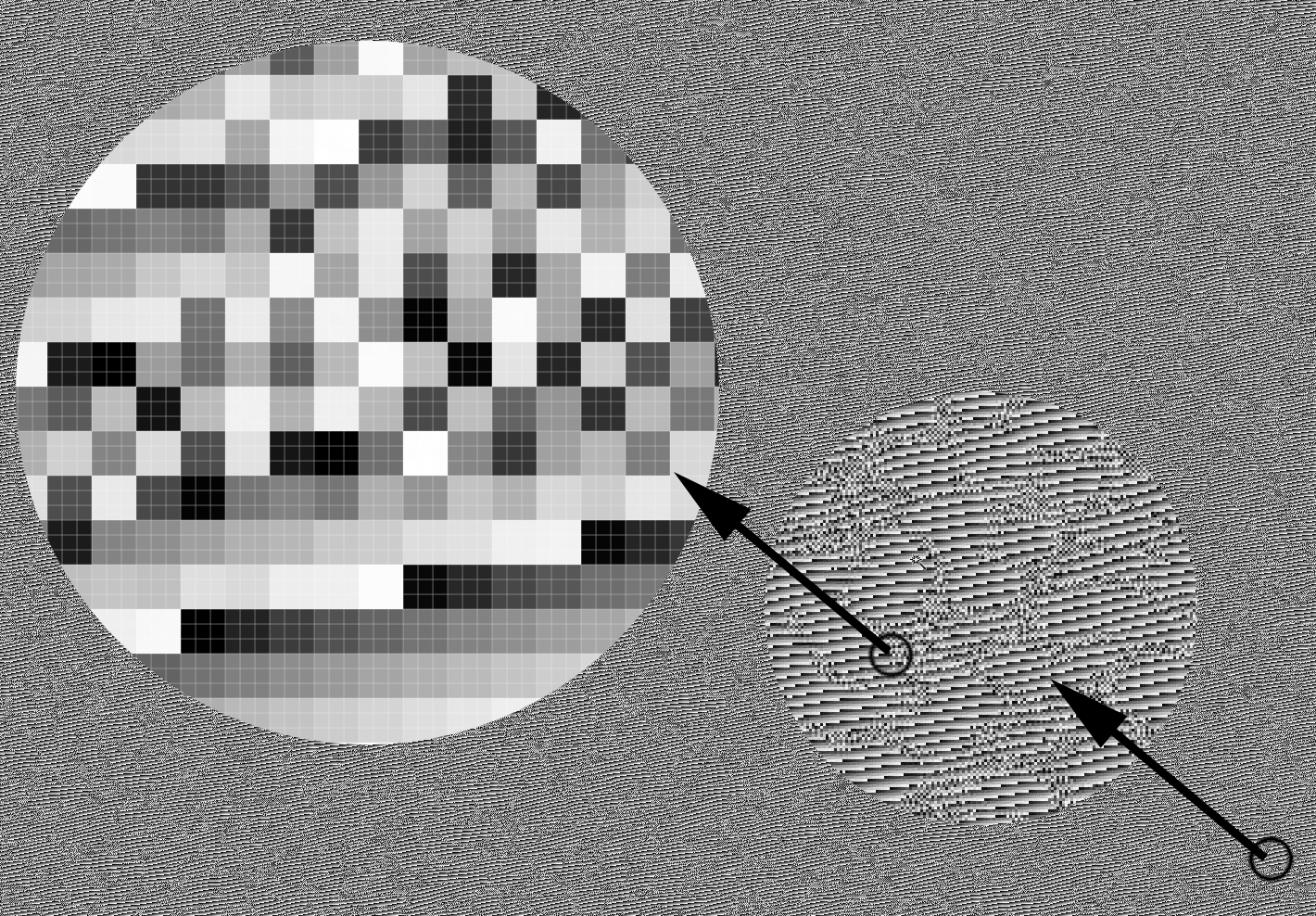
CGH Phase Profile
The CGH profile consists of individual pixels, with each pixel's intensity representing a specific phase value.
A Computer Generated Hologram (CGH) is a type of digital hologram generated using software that can translate application-level content into necessary phase patterns. CGH can create two-dimensional (2D) or three-dimensional (3D) images from a digitally generated pattern. Unlike traditional holography, CGH allows for dynamic content, making it suitable for augmented reality applications. This digital approach to holography overcomes the limitations of traditional photographic methods by allowing the creation of any image on-the-fly, without the need for the physical presence of the object.
Applications of CGH
The potential applications of CGH span various fields, including but not limited to:
- Laser beam manipulation
- Advanced medical procedures such as neurosurgery, dermatology, and oncology
- Advanced optical microscopy
- Optical positioning and control
- Environmental sensing, LIDAR
- Augmented/Mixed Reality (AR/MR)
- Smart glasses, HUDs
- Projection mapping, High Dynamic Range projection
- Gesture recognition, object/player/scene tracking
- CGH's versatility enables it to be used in a multitude of technical, medical, and consumer applications, creating realistic immersive experiences and advanced functional capabilities.
What input sources can be used to create a CGH?
Similar to our analog holograms, CGH content can be created using familiar 3D design and rendering environments, as well as various media assets. We can also encode video feeds, engineering data formats, and utilize Zernike polynomials for arbitrary optical wavefront manipulation.
What are the main differences between traditional near-eye projection and CGH-based projection?
Both traditional near-eye projection and CGH-based projection create virtual images in front of the human eye, overlaying them onto the real world. However, there are significant differences in the technology behind them. Near-eye projection relies on amplitude projectors using laser diodes or LEDs, which require complex illuminating systems to provide uniform illumination and high-quality imaging. On the other hand, CGH projectors utilize diffraction and interference to create virtual images, eliminating the need for uniform illumination and complicated projection lenses. CGH can encode lens functions such as refocusing and image shifting dynamically, and it can even correct deficiencies in the viewer's eyes in real-time.
How about color in CGH?
MD Optical Design's algorithm allows for the generation of full-color CGHs, specifically designed for color-sequential projection. These CGHs are color-corrected to ensure perfect color matching in the images. Alternatively, the microdisplay can be divided into different zones for each color if needed.
Can CGH display motion?
Absolutely! CGHs can dynamically move images in three dimensions, rotate them, stretch or scale them, and more. It is also possible to create independent images or sprites, enabling the selection of different objects within an augmented reality scene.
Does CGH generation require significant computational power?
MD Optical Design employs two approaches for CGH generation. For highly accurate images, such as those used in medical image displays, generation can be done using GPUs (Graphics Processing Units). Conversely, for low-detail, high-dynamic-range images like cartoon figures, highly parallel methods can be implemented using low-power processors or ASICs (Application-Specific Integrated Circuits).
What about replaying CGHs?
Once CGHs have been generated, they can be dynamically modified with minimal computational resources and integer arithmetic. For example, a set of pre-generated CGHs consisting of letters, numerals, icons, and graphical elements can be stored on the microdisplay's driver. The driver can then combine these elements into 3D information for augmented reality content. Additionally, CGHs find exciting applications in virtual retinal displays (VRDs) or retinal projectors (RPs), where images are directly projected onto the retina of the eye, creating a floating display at any distance. CGH technology enables the projection of full-size images onto the retina without moving parts and with reduced optical complexity. Furthermore, phase-based VRDs using CGHs require minimal laser power and are inherently safe for the eyes.
How do MD Optical Design's algorithms compare to traditional methods?
Let's compare three algorithms for generating CGHs with large areas and uniform color filling:
- GS (Gerchberg-Saxton): The classical algorithm with slight modifications for faster convergence.
- IA (Improved Iterative Algorithm): MD Optical Design's version of an improved iterative algorithm.
- OPT (Optimization Algorithm): MD Optical Design's patent-pending optimization algorithm using advanced second-order optimization with analytical gradients.
Simulated reconstructions and actual reconstructions were performed using the same x64 processor without a GPU. The GS and IA algorithms did not provide uniform color fills and exhibited excessive intensity near the object's center, leading to camera "blooming." In contrast, MD Optical Design's OPT algorithm is free from such issues and is highly suitable for low-power real-time operation using parallel hardware and integer implementations.
What unique solutions does MD Optical Design offer for the creation and integration of CGHs?
MD Optical Design is a dedicated group of opto/electronic engineers based in Phoenix, AZ, with extensive experience in holography, numerical software, optical analysis/troubleshooting, analog and high-speed digital electronics, and systems engineering. We provide comprehensive assistance throughout the entire process of introducing new products and technologies, ensuring clarity, accuracy, and avoiding surprises or delays.
MD Optical Design develped advanced algorithms and software solutions for generating CGHs. Alongside this, we also offer hardware, coupling optics, and high-speed electronics necessary for CGH integration into various optical systems.
Our solution can handle a wide range of input sources, including traditional 3D design environments, video feeds, medical data formats, and Zernike polynomials for arbitrary optical wavefront manipulation. The resultant CGHs can be dynamically altered to move in 3D, stretch, scale, rotate, and more, making them incredibly flexible for diverse use cases.Read more about our CGH Generator here
